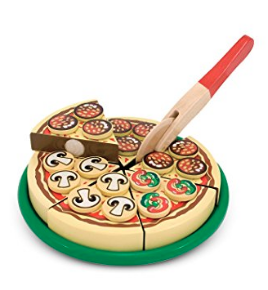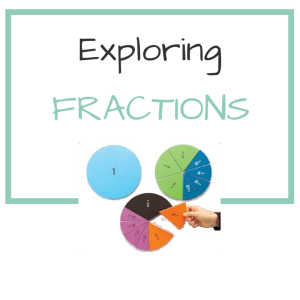When teaching kindergarten math, it’s not necessary to teach fraction symbols such as 1/2, 1/3, 1/4 or to teach advanced fraction vocabulary like equivalent, numerator and denominator.
It is beneficial for young children, when you provide opportunities for them to develop a fraction number sense.
Before they are able to do operations (adding, subtracting…) with fractions, they require lots of time for playing with fraction manipulatives, taking part in fraction games and hearing and experiencing the vocabulary of fractions.
Activities like the ones below will help your students visualize fractions and understand that fraction segments are equal parts of a larger object, skills necessary for more advanced fraction concepts.

As children play fraction games they have opportunities:
- to explore how to place equivalent shapes together to create a whole (for instance, children discover that the curved side of a pie circle segment is on the outside)
- to observe that putting a lot of equivalent segments (e.g. pie shapes) together in a certain way creates a new larger shape (a circle)
- to be introduced to fraction terms (one-third, one-quarter…)
- to explore and compare various shapes that are part of a whole shape
- to investigate how many of each shape makes up a whole shape (4 of the blue pie shape segments make a whole pie)
Start With Pie Sharing Activities
The purpose of this activity is to introduce the idea of equal or same sized pieces and some fraction vocabulary.
Materials:
- thin 6″ paper plates, 1 per student and a couple for the teacher
- scissors for all
Procedure:
- Pretend that a paper plate is a pie and that you are going to share the pie between four students. (You may want to start with 2 pieces, depending on the age of your students)
- Cut two pieces small and the other two pieces large and pretend to pass them out.
- Say, “Would this be a fair way to share the pie? Why?”
- Kids will probably say no it’s not fair!
- Then ask. “How do we know it’s not fair?”
- Compare the four cut pieces by putting one on top of the other.
- Prompt, “These pieces of pie are different sizes so the pie is not shared fairly.
- Is there a better way to share it for 4 people?”
- Ask the children for ideas.
- If a student does not figure out a way to share it equally, then show them how to fold the paper plate in half and then cut it on the fold line.
- Then fold each half equally, open and cut on the fold line so you have 4 pieces.
- Suggest, “The pie pieces are now the same size. (Place one on top of the other)
- This piece is a quarter a pie and this piece is a quarter of a pie and this piece is a quarter a pie and this piece is a quarter of a pie!
- Put them together again to show students how to make a whole pie.”
- Let the children try making 4 equal sized pieces of pie with their own paper plate. The can draw cherries or apples on the paper plates first to make it more pie like.
- At another time, do the same activity but pretend you are sharing it between a different number of kids.
Do similar activities with real food – pizza, a pie, or brownies.
- Start with: This is a whole ___.
- Let’s divide or share it into _ pieces the same size.
- Each piece is the same size and part of the whole ___.
- Use the terms, whole, part of a whole, part of a set, equal, not equal, the same as, not the same as, half, halves, third, thirds, fourth, fourths, a quarter as you play with the children.
